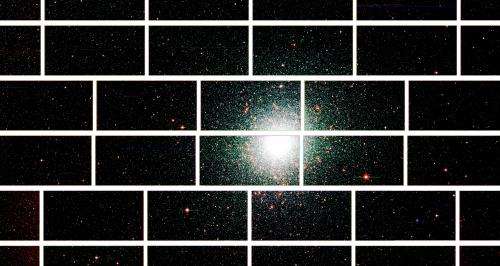Astrophysicists help open eye of world's most powerful digital camera

(Phys.org)—University of Michigan physicists built parts of a telescope camera that just captured its first image in a major survey designed to help scientists understand why the universe is expanding at an ever-faster rate.
The Dark Energy Camera, mounted on the Victor M. Blanco telescope in the mountains of northern Chile, has been called "the most powerful sky-mapping machine ever created," and the "world's most powerful digital camera." With its 570-megapixels and super wide field, it will perform the largest galaxy survey ever undertaken, imaging 300 million galaxies up to 8 billion light years away over the next five years. Each snapshot will capture light from more than 100,000 galaxies.
The camera is the cornerstone instrument of the Dark Energy Survey, a collaboration of 120 scientists from 23 organizations around the world who are working together to understand the mysterious force labeled "dark energy" that is believed to be speeding up the expansion of the universe. Important clues about the nature of dark energy could be found by studying how the distribution of distant galaxies has evolved over the past 8 billion years.
The new camera is a specialized tool for scientists to do this. It will image about one- eighth of the sky through five filters, each a different shade of blue, green, red or infrared—beyond the red that the human eye can see. The camera has an unprecedented sensitivity to very red light, the part of the spectrum where the most distant galaxies reside.
U-M physicists built the mechanism that holds and switches the camera's five filters, which are about the size of manhole covers, says David Gerdes, physics professor in the College of Literature, Science, and the Arts. They also built a system that measures the camera's alignment with the telescope's main mirror, 10 yards away. U-M scientists play leadership roles on several of the collaboration's science teams as well.
"I'm thrilled that the years of work we put into building the world's most powerful camera are starting to pay off," Gerdes says. "This is a proud moment for our department and a great opportunity for us and our students to attack one of the great scientific problems of our time. Understanding dark energy addresses a basic human curiosity about where we came from and what the fate of the universe might be."
Scientists involved in the survey announced this week that the camera had taken its first image, part of testing that will continue until December, when the survey will officially begin. Scientists will use that data to study dark energy using four different techniques, through galaxy clusters, supernovae, the large-scale clumping of galaxies, and weak gravitational lensing. This will be the first time a single experiment will be able to make use of all four of these methods.
Provided by University of Michigan



















